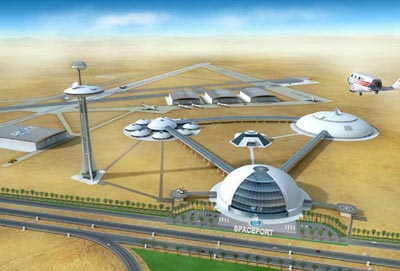Battle of the new spaceportsby Taylor Dinerman
|
| Las Cruces has a good chance of becoming the center of the American space tourism industry. |
Eventually, other activities during the event will include a number of competitions for best turnaround times, altitudes, and payloads for manned suborbital rockets, as well as exhibits and simulations for the public. Next year, the Rocket Racing League will have the finals of its racing series during the event. The organizers hope that over time this annual event will attract thousands of spectators and eventually the X Prize Cup will be to the space industry something like what the Paris Air Show or Farnborough are to aviation.
Its worth remembering that those large French and British events started off as pre-1914 aviation festivals or rallies. The early aviators would compete to see who could fly higher or faster or better than the rest. The original X Prize was inspired by the aviation prizes of that time and of the post-1918 era. Over time these events evolved into the air shows of today, which are basically sales venues for the large aerospace companies with the public allowed in as an afterthought.
One hopes that X Prize Cup will never treat the public with quite the disdain found at the great European shows. One of the important insights to come out of the original Ansari X Prize was that there is a hunger out there for the excitement and spectacle that was once synonymous with aviation and, to a lesser extent, is still there in space exploration. Tapping into that excitement is what the space tourism industry is all about.
By way of contrast, Mojave Airport in California was the first inland location in America to get a commercial spaceport license in June of 2004, at the time of the SpaceShipOne flights. The airport is a natural center for the new industry, but few, if any, people are trying to promote it as such. Certainly the California state government seems to have missed the opportunity to attract the X Prize Cup or anything like it.
Aside from Burt Rutan’s Scaled Composites, Mojave is the home of XCOR Aerospace, a key player in the emerging suborbital rocketplane field; Interorbital Systems, which hopes to develop a water-launched orbital vehicle; and it was the home of the late Rotary Rocket effort. There is also an Orbital Sciences facility there. Mojave seems more like a rocket-centric industrial park than a potential space tourism site. Yet being close to Los Angeles—and all that that implies—they are actually better positioned than Las Cruces to take advantage of the new industry.
| The lesson is obvious: those places that want to become world-class players in the space tourism industry have got to be ready to invest both time and money. |
This is not happening, possibly because the New Mexico state government is not as politically polarized as California’s. Also, New Mexico is a poorer state and is ready to make a real effort to capitalize on every single one of its assets. California has an abundance of resources and if it ends up losing the space tourism industry to New Mexico it will be just one of many that it has lost in the last twenty years. If Boeing has to shut down its plant in Long Beach where they now make the C-17 cargo aircraft, it may be that there will never be another major aircraft project built in the Golden State.
The lesson is obvious: those places that want to become world-class players in the space tourism industry have got to be ready to invest both time and money. Internationally, this holds true for Dubai and Singapore, which have recently expressed interest in becoming regional centers of the industry. The city-state of Singapore has a very strong motivation to build up its expertise in the reusable space launch field. With their restricted position it is not impossible that in the event that their neighbors shut their airspace the only way to get to and from the place would be on a RLV-type rocket. Creating a space tourism site would be a great way to attract business while learning how to build these craft.
Those places that successfully create an attractive place to build and fly space tourism vehicles of various sorts, and which encourage events like the X Prize Cup, are taking a chance investing in this new industry. Nothing is certain, but over time these places will become centers of valuable expertise and will create the kind of virtuous economic cycle that led to today’s Silicon Valley. Some communities and governments believe that it’s a chance worth taking, and the payoff could be huge.
